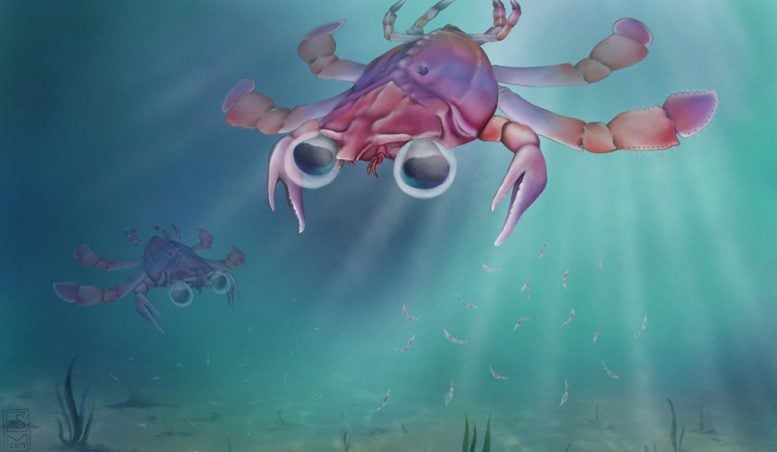
Artistic reconstruction of Callichimaera perplexa: The strangest crab that has ever lived. Credit: Elissa Martin, Yale Peabody Museum of Natural History
The crab family just got a bunch of new cousins, including a 95-million-year-old species that will force scientists to rethink the definition of a crab — and perhaps the disparate ways animals evolve over time.
An international team of researchers led by Yale paleontologist Javier Luque announced the discovery of hundreds of exceptionally well-preserved specimens from rock formations in Colombia and the United States that date back to the mid-Cretaceous period of 90-95 million years ago. The cache includes hundreds of tiny comma shrimp fossils, with their telltale comma-esque curve; several carideans, which are the widely found “true” shrimp; and an entirely new branch of the evolutionary tree for crabs.
The most intriguing discovery, according to the researchers, is Callichimaera perplexa, the earliest example of a swimming arthropod with paddle-like legs since the extinction of sea scorpions more than 250 million years ago. The name derives from the chimera, a mythological creature that has body features from more than one animal. Callichimaera’s full name translates into “perplexing beautiful chimera.”
Video credit: Images by Daniel Ocampo R., Vencejo Films, & Javier Luque, Yale University / animation and 3D reconstruction by Alex Duque.
Callichimaera is about the size of a quarter. Its “unusual and cute” appearance, Luque notes — large compound eyes with no sockets, bent claws, leg-like mouth parts, exposed tail, and long body — are features typical of crab larvae from the open sea. This suggests that some ancient crabs may have retained a few of their larval traits into adulthood, amplified them, and developed a new body architecture. This is an evolutionary process called “heterochrony.”
“Callichimaera perplexa is so unique and strange that it can be considered the platypus of the crab world,” said Luque. “It hints at how novel forms evolve and become so disparate through time. Usually, we think of crabs as big animals with broad carapaces, strong claws, small eyes in long eyestalks, and a small tail tucked under the body. Well, Callichimaera defies all of these ‘crabby’ features and forces a re-think of our definition of what makes a crab a crab.”
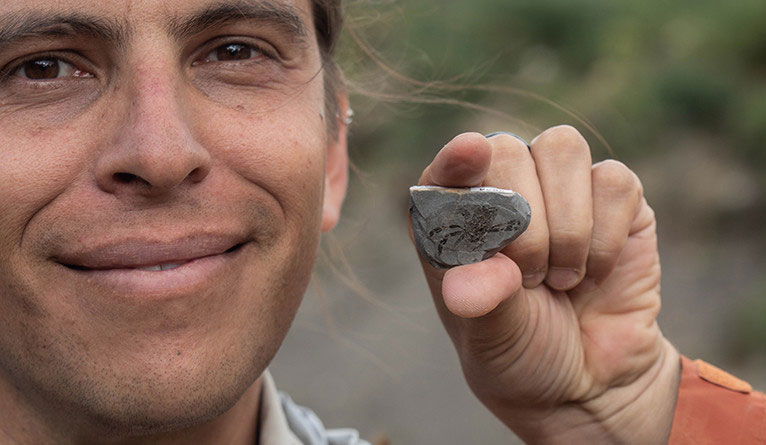
Javier Luque poses with Callichimaera perplexa — a 95-million-year-old species that will force scientists to rethink the definition of a crab. Credit: Daniel Ocampo R., Vencejo Films
Luque also noted the significance of making the discovery in a tropical region of the world. There are fewer researchers actively looking for fossils in the tropics, he said, and the amount of ground cover and thick vegetation of tropical forests make access to well-exposed rocks more challenging.
“It is very exciting that today we keep finding completely new branches in the tree of life from a distant past, especially from regions like the tropics, which despite being hotspots of diversity today, are places we know the least about in terms of their past diversity,” Luque said.
Luque’s team included researchers from the University of Alberta, Kent State University, the University of Montreal, the Smithsonian Tropical Research Institute in Panama, the Canadian Parks and Wilderness Society, the National Autonomous University of Mexico, the University of Nevada, and the College of Communication and Design in Boca Raton, Florida.
Reference: “Exceptional preservation of mid-Cretaceous marine arthropods and the evolution of novel forms via heterochrony” by J. Luque, R. M. Feldmann, O. Vernygora, C. E. Schweitzer, C. B. Cameron, K. A. kerr, F. J. Vega, A. Duque, M. Strange, A. R. Palmer and C. Jaramillo, 24 Apr 2019, Science Advances.
DOI: 10.1126/sciadv.aav3875

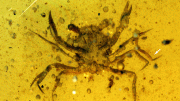
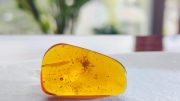
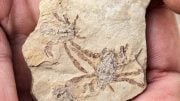

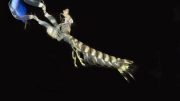
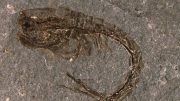


“Heterochrony” is a general term for body parts and organ systems that develop “out of sync” with one another, some developing faster or slower than would be typical. The type resulting n the retention of juvenile traits into adulthood is called “neoteny”, which is the term that should be used for Callichimaera.
They never tell me what I really want to know about these critters: what did it taste like? It looks delicious!
El,
One might assume they taste like rock crabs….
If nobody was around to taste them, did they even have a flavor?
Have you seen Crab versus Scorpion fights to death ? Crab Won ! because Scorpion cant inject a poison on crab.